|
"LOLONG" - Lessons in Managing Large
Crocodiles
By: Dr. Jose Andres L.
Diaz, DVM, FPCVPH
Lolong’s life and death is a good learning experience for the enhancement
of managing our wildlife resources particularly crocodiles. In many areas
around the world where predators are found, there are instances where
these predators attack, kill and eat humans and regarded as problem
animals. Most famous of these are the man-eating lions and leopards of
Africa, tigers of India and crocodilians in many parts of the world, most
notorious of which are the Nile crocodiles of Africa and the saltwater or
estuarine crocodiles of the Indo-Pacific region. Traditionally the
accepted approach to these problem animals is hunting and killing them to
save the human populations from further harm
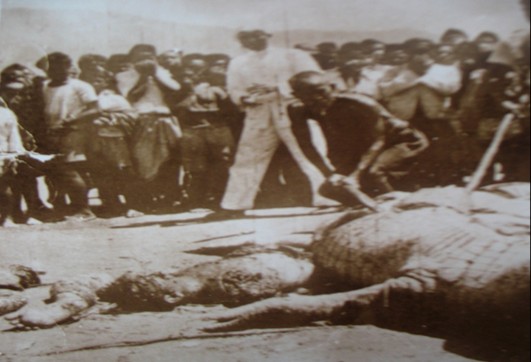
Human remains being retrieved from a man-eater croc
The celebrated hunter Jim Corbett killed many man-eating lions and
leopards and later became a famous conservationist. In the Philippines,
the famous crocodile hunter Mitsi Barsia is still regarded as a savior in
many remote areas where he killed many man-eating crocodiles. The
legendary Muslim crocodile hunters who served as a stimulus in the
settling of remote crocodile infested wetlands suitable for paddy rice
farming and aquaculture, were driven more for economic reason. The
crocodile skins are among the prized commodities in their trade to the
south eventually reaching Singapore which up to the present is the center
for crocodile skin trade in Asia. Even the current Wildlife Resources
Conservation Act of the Philippines (RA 9417) which makes it illegal to
kill and destroy wildlife exempts this in instances where there is danger
to life a limb of humans (sec 27).
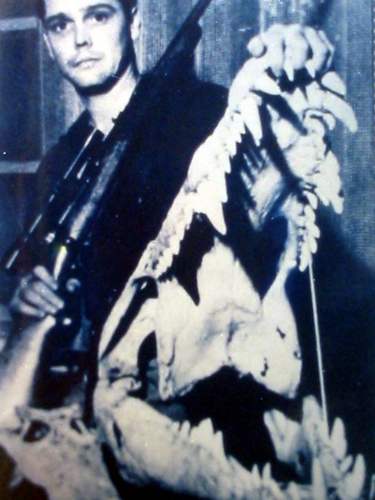
Mitsi Barsia killed thousands of crocodiles in the
1950”s to 60’s and inspired the comics series Putol.
At the start of the Palawan Project I asked him
how to get the crocodiles alive and he replied that he had no idea.
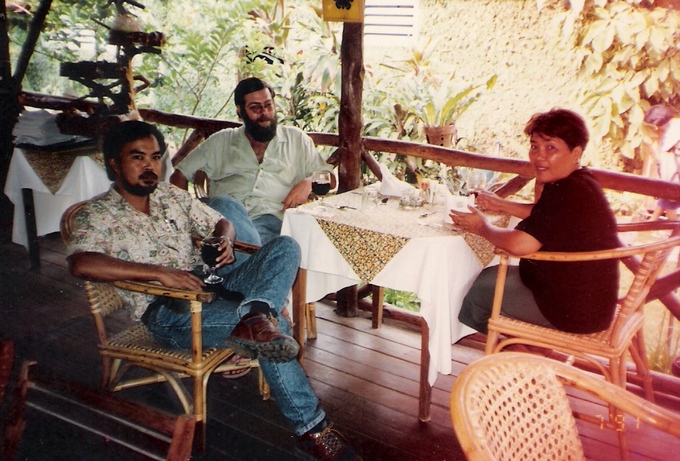
Charles Andy Ross, a herpetologist from the
Smithsonian Institution and considered the authority on crocodiles in the
Philippines. He pioneered and tirelessly promoted the conservation of
crocodiles in the country. Taken at the popular Badjao Inn, Puerto
Princesa, Palawan with Zeny Mendoza, wife of Brod Dr. Sonny Mendoza -
owners, during the heyday of crocodile trapping for the Palawan Crocodile
Institute where I served as the Founding Director.
The paradigm shift in treating crocodiles started with the establishment
of the RP-Japan Crocodile Farming Institute (or CFI) in Palawan in 1986
(now Palawan Wildlife Rescue and Conservation Center or PWRCC). The
primary aim of the institute is to remove the conflict between humans and
crocodiles by capturing alive the problem crocodiles and bring them to the
breeding facility to serve as breeders - thereby conserving the endangered
species. A gratuitous permit was issued by DENR and more than a hundred
large saltwater crocodiles (Crocodylus porosus) were captured from all
over the country and became the breeding stocks which produced the present
crocodile industry in the Philippines now numbering to more than 30,000
animals. This industry regularly supplies farmed CITES registered
saltwater crocodile skins to the famous Hermes fashion house. This effort
also involved the conservation of the endemic Philippine crocodile (Crocodylus
mindorensis) which is highly endangered and numbered only some 200
individuals now successfully bred in captivity and reintroduction to its
natural habitat is ongoing. The conservation of crocodiles is regarded as
the most successful program in conserving Philippine endangered wildlife
species.
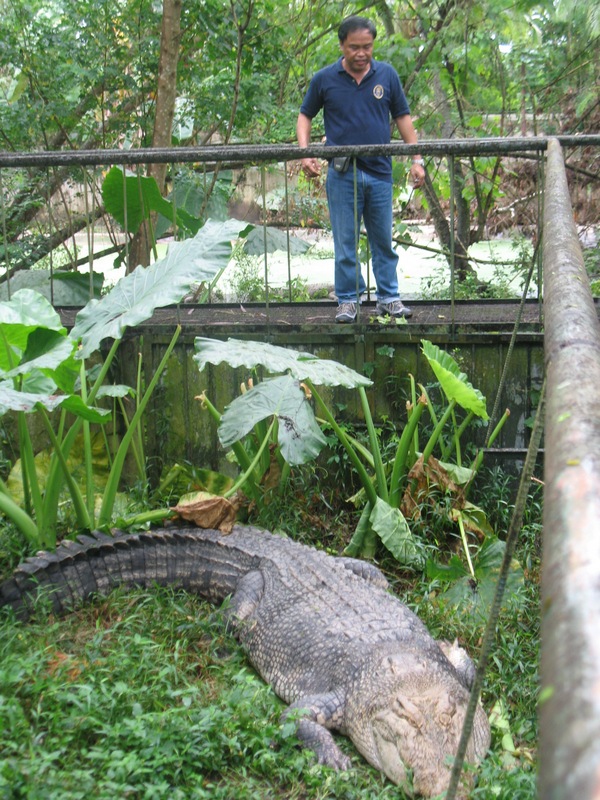
A large former man-eater that served as breeder in the
Palawan croc farm
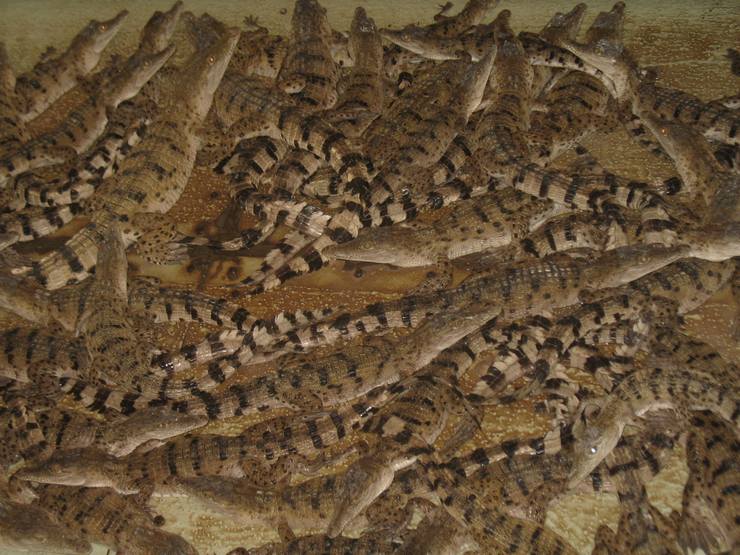
Third generation farmed saltwater crocodiles
In 1992, the National Integrated Protected Areas System Act was enacted.
Among the protected areas declared was the Agusan Marsh Wildlife Sanctuary
(est.1996). It aims to conserve the role of the Agusan Marsh as the catch
basin for the region, thereby managing its seasonal flooding and
conserving the many flora and fauna found therein, including the last
remaining intact crocodile habitats and large natural crocodile population
left in the country. As in many parts of the Philippines, Agusan Marsh
Wildlife Sanctuary has many human settlements in its periphery. Human
activities both indigenous and migrant have traditionally been an integral
part of the whole area where people travel, fish and collect resources.
The management of the Protected Areas has to closely integrate the
presence of the large potentially dangerous crocodiles with the inevitable
human activities. Before the Agusan Marsh’s declaration as a Protected
Area, any actual or perceived threat to humans by crocodiles is promptly
addressed by simply killing the problem crocodiles through community
effort. Nobody from the community would even inform the authorities as
everybody believes that it is the proper thing to do.
In 2009, I was requested by an old friend in crocodile conservation and
diving buddy, Sonny Dizon, to help the mayor of Bunawan, Agusan del Sur to
address the problem of man-eating crocodiles in their area. We met Mayor Elorde in Davao who needed help to kill the problem crocodiles. I advised
him to capture the animals instead and make use of it as an educational
medium and tourist attraction. He initially could not comprehend the idea of
capturing and keeping alive a huge man eating crocodile. We conducted in Bunawan (with PAWB and PWRCC staff) an orientation and training program on
the conservation of crocodiles focusing on the techniques to safely
capture, handle and manage crocodiles in captivity and demonstrated the
use of crocodile snares to the local crew who will undertake the trapping.
These snares are copies of the original from Zimbabwe which we imported
years back and successfully used in capturing alive the many crocodiles in
the Palawan farm.
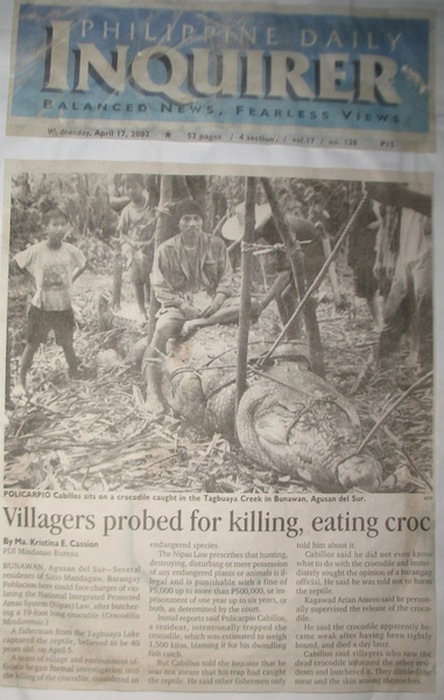
A 19 footer saltwater crocodile caught in Bunawan in
2002.The animal subsequently died and the meat eaten by the locals as
traditionally done. The lack of definite policy and program on how to
manage large man-eaters will end up with casualties on both sides and
worsen the relationship between humans and crocodiles.
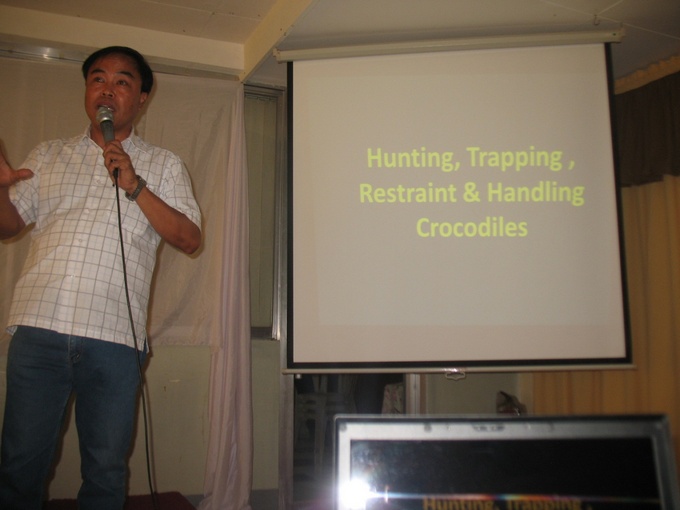
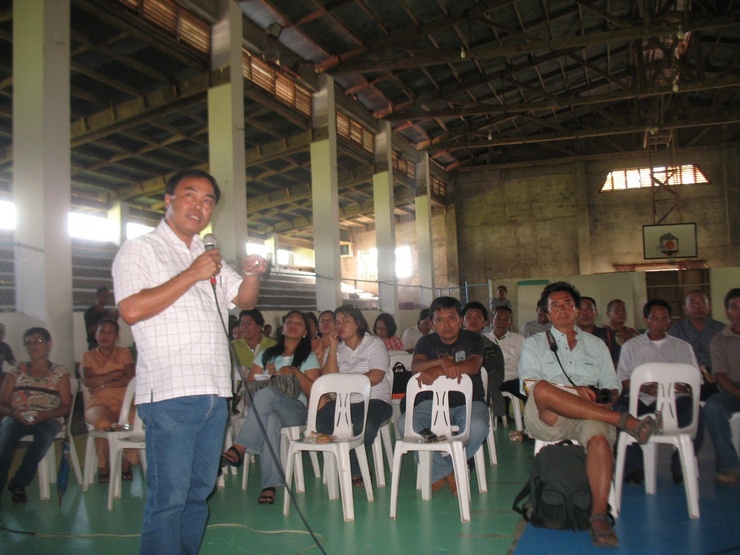
Orientation and training on the conservation including
capture techniques and captive management
of crocodiles held in Bunawan. The participants
eventually captured and managed Lolong.
I also advised them to acquire the proper permits from the DENR and ensure
that the facility to keep the crocodile must be ready before they even
start the trapping. The facility must conform to a design suitable for
large wild caught crocodile and nearest to the habitat to reduce stress of
handling and transport. I emphasized that the common experience in
Australia, which has the best program in conserving salt water crocodiles
and our model, is the death of huge wild caught crocodiles due to stress
of capture, handling and transport over long distance. These mortalities
occur a few days after capture and later found out to be due to the
accumulation of lactic acid in the muscles as a result of anaerobic
exertion due to prolonged handling and transport. We learned this lesson
in our years of catching large crocodiles and while we had a few
mortalities, most wild caught large crocodiles eventually became breeders.
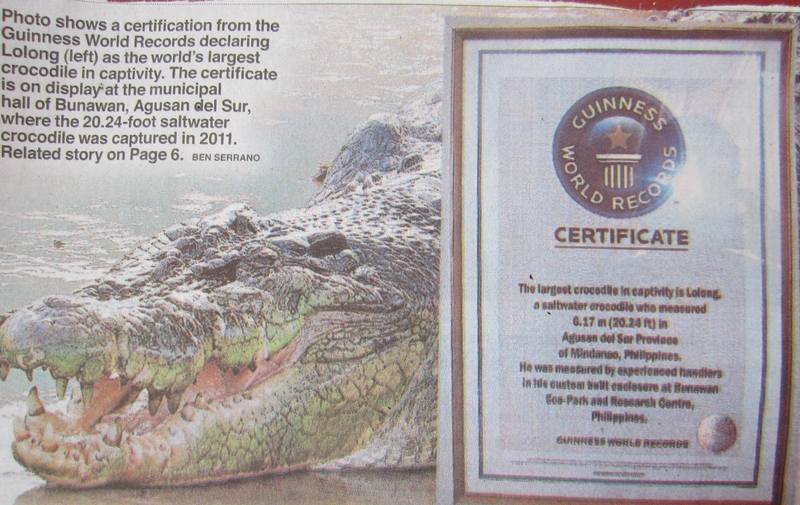
Lolong is one of the few large crocodiles left in the
country and became popular because it was captured alive.
The others were simply killed by the locals ,hidden
and simply ignored by the authorities and conveniently forgotten.
It took some time for the DENR to issue a permit to catch the problem
crocodile and a team from PWRCC was dispatched to the area accompanied by
the locals. Unfortunately, a member of the PWRCC team - Lolong Conate - died
and when his remains was brought to Palawan; the locals continued the
trapping and caught a big crocodile. The crocodile was named Lolong in
honor of the trapper and turned out to be the biggest in the world. This
transformed Bunawan from an unknown, remote 5th class town into celebrity
status. Immediately there was a chorus of attention grabbing circus
ranging from animal rights clamor to release the animal or to bringing
the crocodile to Manila. The Bunawan facility was recognized by the
authorities, regularly monitored, extended technical support and became a
big tourist attraction. The latter brought big income and prestige to the
community.
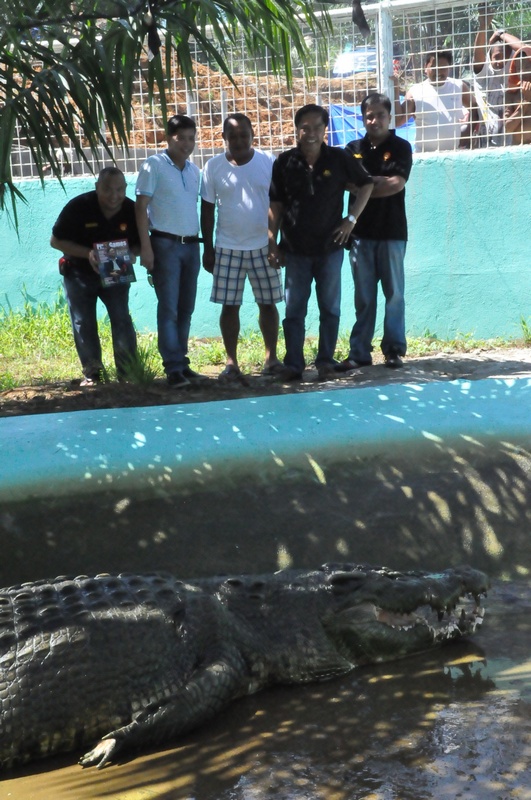
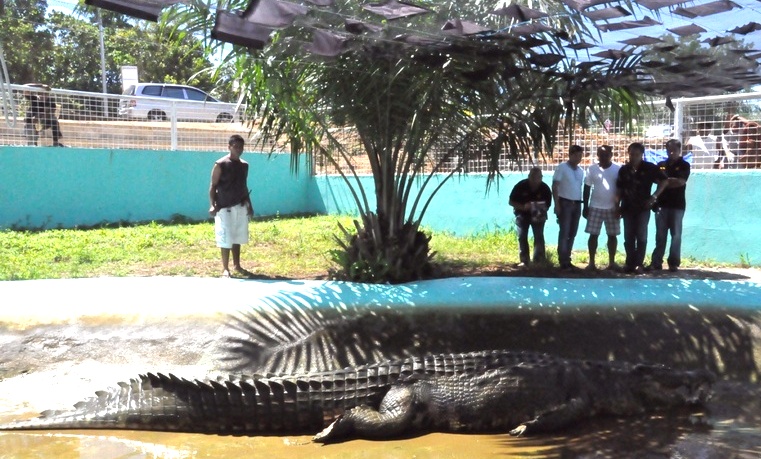
Visit to Lolong as part of continuous support
to manage the largest crocodile in the world.
The facility is far better than the usual
crocodile pen with dedicated staff and tight security including 24 hour
camera monitors.
In our visit to Lolong in 2012, we observed that the facility needs proper
signages to attract more attention and bring in more visitors. It is good
that the Mayor immediately agreed to partner with Dr. Ayong Lorenzo, owner
of Excellence Poultry and Livestock Corp and El Dia Crocodile Farm as part
of his corporate social responsibility to promote the conservation of
crocodiles. Immediately, signages were established in the main highway of
Agusan and in the road towards the crocodile facility, greatly increasing
the number of visitors.
After successfully managing Lolong in captivity for one and a half years,
the biggest crocodile in the world died. Again, there was a chorus of
condemnation and finger pointing as to the culprit in the whole episode.
The authorities conducted a necropsy and declared that the cause of death
is ‘’chronic pneumonia complicated by multiple organ failure’’ (Phil Star,
March 3, 2013).
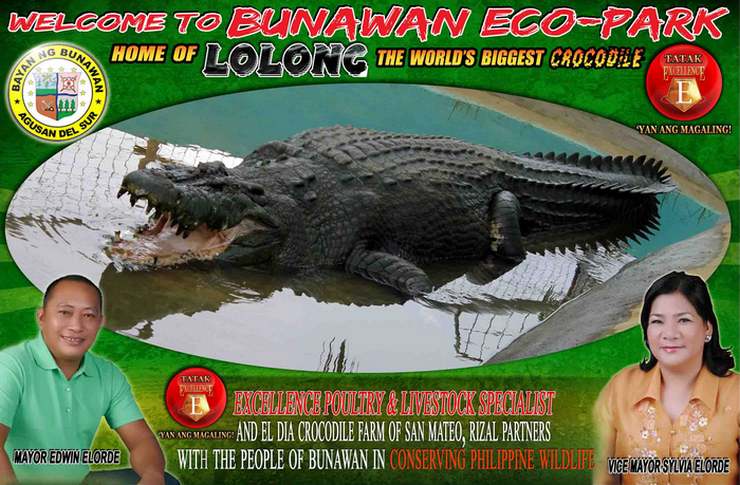
Signages to promote Lolong which brought mixed
results. Many appreciated the effort and
brought prosperity and fame to the
remote town. Others criticized it to gain media attention .
Some lessons learned:
1. What is our policy regarding problem crocodiles?
If we conserve crocodiles in the wild, inevitably we will have problem
crocodiles. Small crocodiles will one day become big, aggressive and take
bigger prey to satisfy their bigger appetites and end up to eating people.
Protected areas cannot be off limits to people especially in the
Philippines with exploding population and poor law enforcement. People
will inevitably end up as crocodile prey when they enter crocodile habitat
where problem crocodiles rule.
Big old crocodiles hold large territories and they would kill and devour
interlopers inside their territories whether it is a smaller crocodile or
a human being. According to Australian Dr Graham Webb, the world’s
foremost authority on salt water crocodiles, the biggest threat to other
crocodiles in a natural population is an old big dominant crocodile (that
is aside from humans). It will kill and devour the smaller ones in its
territory. This coupled with the danger to humans as recognized in the
wildlife law of the Philippines (that is instead of allowing the killing
of crocodiles attacking humans) is enough reason to address the concern on
problem crocodile by removing and keeping them in a safe facility. This
approach is an integral component in the successful management of
crocodilians in many parts of the world.
At the time when Lolong is celebrated as the world’s largest, there has
been a clamor by the people of Bunawan to be allowed to capture another
large man eater in the area as it has been attacking livestock after
devouring a local inhabitant. The request has been ignored as the debate
on what to do with Lolong (alive and dead) is ongoing.
The Agusan Marsh Wildlife Sanctuary gives priority in managing the natural
population of crocodiles in the area. It must also prioritize the proper
relationship between the crocodiles and the inhabitants that are affected
- either as living around or inside and doing activities inside.
The Agusan Marsh Wildlife Sanctuary under the DENR has an office in
Bunawan but only the LGU has a facility to maintain large captive
crocodiles. The management of the AMWS has to recognize the role of that
facility in managing the crocodiles therein.
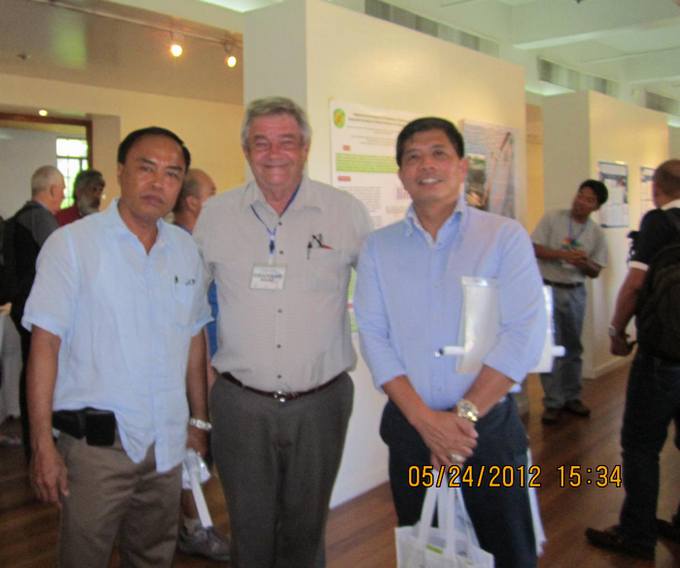
With Dr Graham Webb and Brod Dr Ayong Lorenzo during
the Crocodile Specialist Group meeting held at the National Museum of the
Philippines. The El Dia Crocodile Farm we established maintains both
Philippine crocodile and saltwater crocodile. It is among the few
facilities that successfully bred in captivity the endemic and highly
endangered Philippine crocodile.
2. What really killed Lolong?
Was it swallowing a length of rope as earlier reported? Was it the
rumored deliberate poisoning to embarrass the mayor who is running in the
next election? Was it due to stress and mismanagement due to the greed in
bringing in more tourist and money as repeatedly harped on? Was it a case
of chronic fungal infection of the lungs which made Lolong "not feeling
well even before his capture and taking Lolong from its natural habitat to
its new home made its condition worse’’, this fungal infection made
breathing difficult, affected its heart, leading to congestive heart
failure and death? (Phil Star, Mar 3, 2013)
The necropsy conducted by veterinarians from PAWB, PWRCC and Davao
Crocodile Park did not see any rope. They also did not conduct a
toxicological examination.
Sample tissues, however were collected and sent to UPLB College of
Veterinary Medicine for histological pathological examination. The result
of the UPLBCVM examination is chronic respiratory disease due to fungal
infection.
Philippine authorities state that Lolong’s age is estimated to be between
50 and 60 years old. Some say that crocodiles live up to a hundred years.
There is no reliable way of determining the age of a crocodile especially
from the wild. The only way to reliably know a crocodile’s age is to keep
a record from day one.
In the book Eyelids of Morning by Alistair Graham and Peter Beard, my
treasure from the visit to the Smithsonian Museum as recommended by my old
buddy and mentor croc expert Andy Ross, the authors made a survey of
crocodilians the age of which were reliably recorded and found out that
the greatest age recorded by any zoo for any species of crocodilian is
less than 60 years.
Lolong measures 20.24 feet and weighs 1000kg - the longest/largest in the
world as confirmed by the Guinness world record.
The same book “Eyelids of Morning ”which according to the Chicago Tribune
is “probably the best book ever written about crocodiles”, retells the
account of the biggest crocodile ever .
In 1825,a Frenchman, Paul de la Geroniere who lived in Luzon, Philippines
was greatly annoyed by a crocodile that killed and ate one of his horses.
Assembling a posse of spearmen, he led a chaotic tallyho after the croc,
which because of its bulk and the smallness of the river, was unable to
escape. Nevertheless, six hours and uncounted spear thrusts later it was
still alive. La Gironiere had fired several shots from close range, once
into the reptile’s mouth, seemingly without effect. In fact he later found
that his musket caused scarcely any injury. Then a resourceful hunter
drove a lance into the animal’s back with a hammer and by a fluke found
the spinal cord and killed the croc.
The beast was so heavy it took all 40 hunters to roll it ashore. ”When at
last we had got him completely out of the water we stood stupefied with
astonishment .From the extremity of its nostrils to the tip of its tail,
he was found to be 27 feet long, and his circumference was 11 feet,
measured under the armpits. His belly was much more voluminous ,but we
thought it unnecessary to measure him there ,judging that that the horse
that he had breakfasted must considerably have increased his bulk…”
La Geroniere was so impressed by his prize that he carefully prepared the
skull and sent it to the Agassiz Museum at Harvard. Nearly a century
later, in 1924, Thomas Barbour, the herpetologist searched the Agassiz
Museum for La Gironiere’s croc. Sure enough he found an enormous skull,
unfortunately unlabelled, but of an estuarine croc with a palate injury
corresponding to La Gironiere’s musket shot. It is highly likely that this
the one from Luzon; but if it is, then La Gironiere’s tale (written 29
years after killing the croc) is tainted a little with fabulous tradition,
for the skull measures a fraction less than 36 inches. Since the length of
a croc’s head is not more than one-seventh of total length, it is easy to
calculate that the croc was only 21 feet long not 27. Nevertheless ,this
is still the ”all-time world-record” croc. The difficulty the hunters had
rolling it out of the river is not surprising, for a 21 footer would weigh
1.25 tons.”
If Lolong is 50 years old and expected to live up to 100 years, what would
be its maximum size at that age? Could it be possible that given Lolong’s
maximum size and weight, it has also reached its maximum age.
If the reason for the death is stress, crocodiles have evolved to live a
very stressful and violent life. They have survived from the age of
dinosaurs. They are apex predators that hunt and attack large dangerous
prey and thrive on diseased rotting carcasses in the wild. In fact the
current research is focused on utilizing crocodile serum to treat a
variety of infections including HIV, proving that crocodiles can resist
many diseases that can kill other animals. Crocodiles survive and thrive
in captive conditions that could otherwise kill other creatures.
Or maybe Lolong has reached its life’s end, being too old, lost its super
resistance and therefore bound to die?
In managing wildlife in captivity, the inevitability of death especially
of old animals is an accepted fact.
3. What do we do when something like Lolong dies?
Recognizing the inevitable death of an old valuable specimen, there must
be a program to handle its remains as soon as the animal dies.
Arrangements must be done in advance how to immediately manage the carcass
so as to prevent deterioration. Identification and coordination with
experts who will do the necropsy and taxidermy should be done in advance.
The necropsy team should be accompanied by the taxidermy team to ensure
that the proper cuts would eventually produce both necropsy findings and
proper preservation of the remains. Valuable parts and specimens that
should be preserved for different reasons, if only for posterity should be
systematically done.
Lolong is the biggest crocodile in the world and given the expanding
crocodile farming industry in the country it could have been a good
opportunity to preserve its genetics - both somatic and reproductive
tissues from the testicles with sperm cells to serve as future source of
genetically important materials. Saltwater crocodiles are the largest of
the extant reptiles .Their skin is the most prized and most expensive of
all crocodilians. The two largest specimens recorded come from the
Philippines. The Philippine saltwater crocodile populations could have the
unique genetics to produce the largest in the world and very valuable in
improving the genetics of farmed crocodiles. The serum, and other organs
alike, the heart, penis, eyes, etc. and even the gastroliths are valuable
natural heritage of once was the biggest crocodile in the world.
I was informed that the skin was salted and stored waiting for
bureaucratic decision and that the bones would be eventually dug up after
the skinless carcass was buried to decompose.
Maybe, that is the tragedy of Lolong. It was looked upon as another
crocodile that at best will eventually be preserved for tourists. Its
value as a unique specimen and a national natural treasure seems to have
been lost.
However, all is not lost if we learn from this incident and apply it to
the better management of our precious wildlife species. Then the death of
Lolong would not have been in vain.

(Back --->
Environmental Awareness)
(Back ---> Current Features)
|

